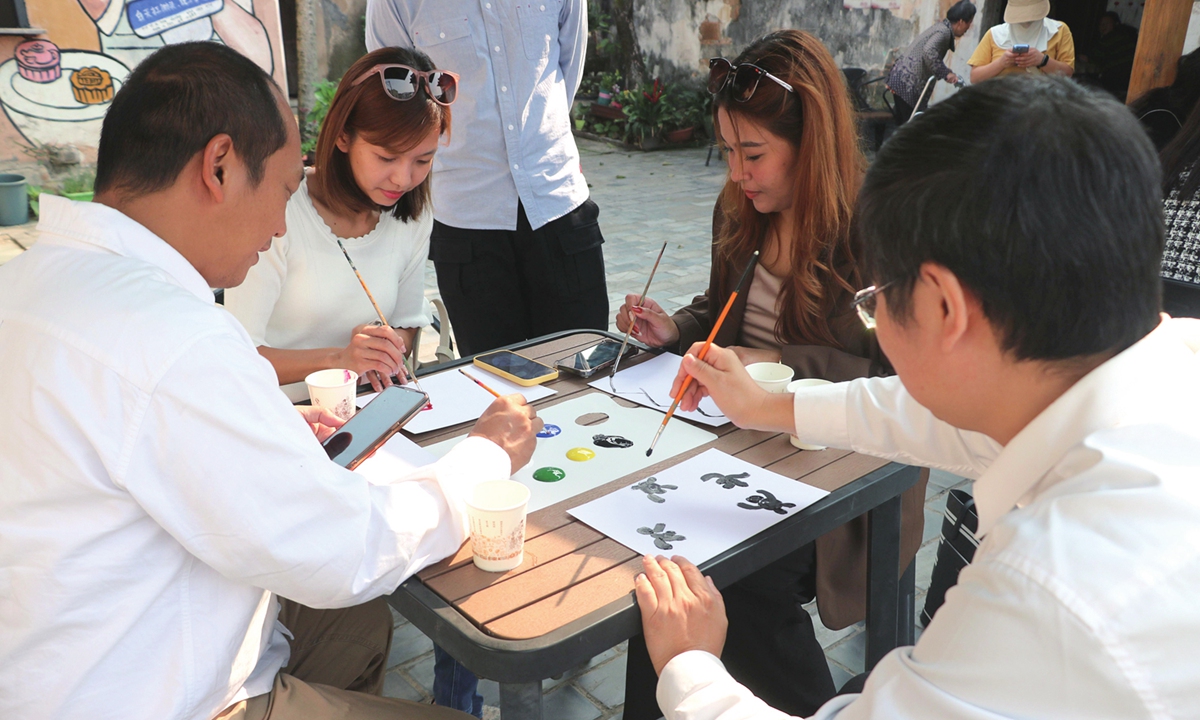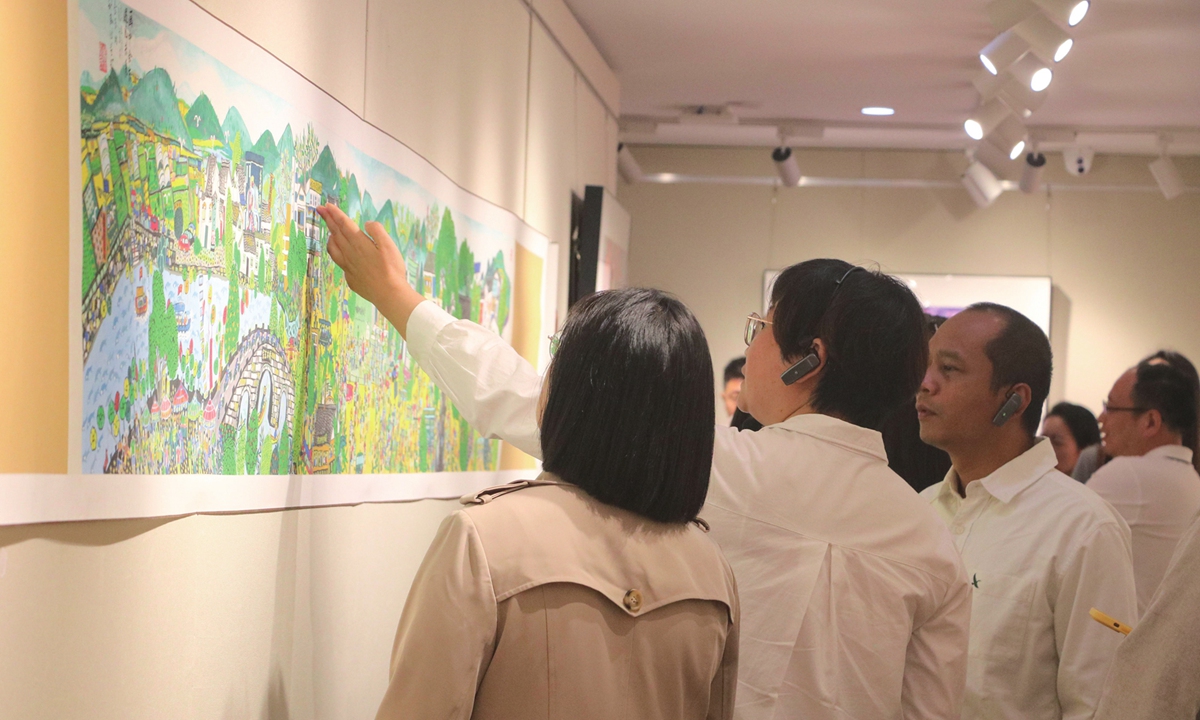
Diplomats learn painting in the Yudong villege in the Kecheng district of Quzhou, Zhejiang, on October 28, 2023. Photo: Courtesy of Quzhou Southern Confucianism Cultural Development Center
Editor's Note:
In his report to the 20th National Congress of the Communist Party of China (CPC), Xi Jinping, general secretary of the CPC Central Committee, proposed to comprehensively advance the great rejuvenation of the Chinese nation on all fronts through a Chinese path to modernization - the modernization of a huge population, of common prosperity for all, of material and cultural-ethical advancement, of harmony between humanity and nature, and of peaceful development.For a long time, the Western perspective has dominated the narrative on modernization. However, China's extraordinary achievements in all aspects demonstrate that there are alternative methods to modernization. The Chinese modernization is a new model for human advancement, and dispels the myth that "modernization is equal to Westernization," presents another picture of modernization, expands the channels for developing countries to achieve modernization, and provides a Chinese solution to aid the exploration of a better social system for humanity.
To understand the Chinese path to modernization, the Global Times is launching a new series that explores how expatriates perceive Chinese modernization through on-site experiences in the country. In this installment, the Global Times follow diplomats from the Association of Southeast Asian Nations (ASEAN)-China Centre (ACC) and ASEAN member states on their to visit Quzhou in East China's Zhejiang Province, to understand how they perceive the practice of Chinese modernization as seen in the city. Quzhou, located in East China's Zhejiang Province, is the second hometown of the direct descendants of great Chinese philosopher and educator Confucius (551-479 BC). The city not only boasts beautiful natural scenery and profound cultural heritage, but has also made remarkable use of its heritage to boost modernization and, step by step, realize a futuristic vision, with its ancient wisdom as a cultural calling card and culture brand for a modernized Quzhou.
In preparation for the celebration of the ASEAN-China Year of People-to-people Exchanges in 2024, the School of Government and Public Affairs at the Communication University of China (CUC) in Beijing held the Decoding Chinese Path to Modernization Workshop Series, with some diplomats from the ACC and five ASEAN member states in attendance and taking part in a visit to Quzhou from October 26 to 28 to witness local experiences in Chinese modernization and draw inspiration for the development of ASEAN member states.
As China and ASEAN member states are close neighbors connected geographically and culturally, these successful experiences hold more significance as references for developing countries in Southeast Asia, experts and diplomats hailed.
Ancient vs Modern The first evidence of Quzhou's success in historical culture-modernization integration is the figures and logos of nankong yeye (Grandpa Confucius), a cute and vivid cartoon figure based on Confucius that can be seen everywhere, from the airport and schools to the city's streets and shopping centers.
The figure is not only a reappearance of the great philosopher, but also a testament to the enduring spirit and legacy of Confucianism is in all aspects of daily life in the city.
Visiting team diplomats gained a deeper understanding of this after touring Confucius Ancestral Temple, which is one of the only two Confucius family temples left in China, and is known as the Nanzong Confucius Temple (the Southern Temple).
"The main purpose of our visit here is to learn from Quzhou city, especially on how to preserve culture, but at the same time to pursue development and modernization in China. I think we have learned a lot from how Quzhou city preserves its culture and heritage of Confucianism. We also learned how the Confucius family migrated from the northern part of China to the south. It's very interesting and I think we can follow or at least learn how a city preserved its culture while still modernizing," Director Hadi Tjahjono of Education, Culture, and Tourism Division, from the ACC, told the Global Times.
Many diplomats were also impressed by how the people of Quzhou continue to inherit the ancient Confucian spirit while seeking modern prosperity.
To the delegation, Quzhou serves as a vivid example of how China is making full use of its existing cultural advantages and advancing modernization through rural development.
Such modernization prioritizes green, peaceful, ecological and people-oriented approaches, different from exploitative, militaristic, and invasive Western strategies aimed at the accumulation of wealth, they said.
People-oriented approach 
Diplomats from the ASEAN-China Centre and some ASEAN member states visit the China Village Art Museum in Quzhou, East China's Zhejiang Province, on October 27, 2023. Photo: Courtesy of Quzhou Southern Confucianism Cultural Development Center
A diplomat in the visiting delegation took the Yudong village in Kecheng district as an example to explain her understanding of this perspective. At first, it was a few painting enthusiasts who voluntarily gathered to learn and shared their thoughts on painting in the 1970s. When it comes to the new era of modernization, the local governments did not harshly impede the farmers' creative hobbies, but provide them with support and a stage to shine.
After decades of development under the support of local authorities, now 300 among its 800 residents are skilled at painting and the skill has grown into a comprehensive industry. The village was included by the National Rural Revitalization Administration in a list of national typical cases of characteristic culture and art in March this year.
According to media reports, the collective operating income of the Yudong painting village jumped from about 100,000 yuan ($13,666) in 2019 to 1.12 million yuan in 2022, a significant boost to the local economy. The output value of industries related to farmer painting exceeded 20 million yuan in 2022, helping villagers find jobs close to their homes. In 2019, the output value of industries related to farmer painting was about 8 million yuan.
The diplomat told the Global Times, on condition of anonymity, that she was impressed by a sentence on a Yudong village wall, which says: "Culture is also a source of growth and productivity; it is capable of driving the masses toward prosperity."
The success of Yudong proves this is true, the diplomat said.
Deeper social transformation
Quzhou is just one of the many examples demonstrating that urbanization and modernization in China are not only aimed at promoting material changes in cities, but also a deeper social transformation, including cultural and environmental transitions.
"In 2015, I came to Beijing as a member of a delegation. Now, I am working in China and able to witness the changes happening here. For example, in Sanlitun, I see constant and rapid changes every day. As a citizen of one of the ASEAN member states, I am very pleased to see these developments," Seint Shwe Zin, a diplomat from the Embassy of Myanmar in China, said at a seminar held in Beijing before the Quzhou visit.
When I came to China to study Chinese 10 years ago, they gave me a book called "Modern Chinese." From the development of education, we can see modernization via the changes of the use of technology and scientific methods in teaching or learning, as well as the tools used by teachers, Chindavong Xaiyasin, a diplomat from the Embassy of Laos in China, said at the seminar.
Now living and working in Beijing, Chindavong showed strong interest in how Beijing developed the Liangma River - a small, dirty river where caravans would cleanse and refresh their horses before entering Beijing in the olden times, building the area into the "Seine of Beijing."
Laos is also facing similar challenges while in the process of developing the capital. I hope we can take the restoration and development of the Liangma River as an example, Chindavong told the Global Times.
ASEAN member states and China should share and learn more from the latter's successful experiences in modernization as China-ASEAN relations mature further and grow close, experts and diplomats agreed.





